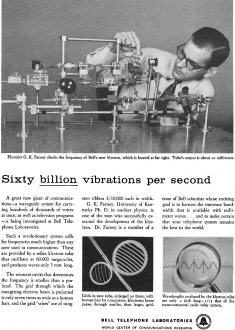|
May 1956 Radio-Electronics
 [Table of Contents] [Table of Contents]
Wax nostalgic about and learn from the history of early electronics.
See articles from Radio-Electronics,
published 1930-1988. All copyrights hereby acknowledged.
|
The
Varian brothers, Russell and Sigurd, are widely credited for invention of the
klystron around 1937. Credit for further developments in the klystron - from its
technology to origin of the name - is a bit fuzzy based on many articles I have
seen. According to a 1944 Radio News magazine article,
Sperry Gyroscope Company
developed the tube into commercial viability and was assigned the trademark name
"klystron" based on their creation of the field of "klystronics." However, the Wikipedia
entry for Stanford professor
Hermann Fränkel claims the name "klystron" was suggested by him. This full-page
Bell Telephone Labs promotion in a 1956 issue of Radio-Electronics magazine
tells of their 60 GHz klystron design by employee G.K. Farney, but makes
no mention of the device's history. Bell Labs is unquestionably responsible for
untold numbers of paradigm-changing inventions, but for some reason the omission
of that information - especially so close in time to the klystron's arrival on the
commercial scene - bothers me a bit.
Bell Telephone Laboratories - The Klystron
 Physicist G. K. Farney checks the frequency
of Bell's new klystron, which is located at far right. Tube's output is about 20
milliwatts. Physicist G. K. Farney checks the frequency
of Bell's new klystron, which is located at far right. Tube's output is about 20
milliwatts.
Sixty billion vibrations per second
A great new giant of communications - a waveguide system for carrying hundreds
of thousands of voices at once, as well as television programs - is being investigated
at Bell Telephone Laboratories.
Such a revolutionary system calls for frequencies much higher than any now used
in communications. These are provided by a reflex klystron tube that oscillates
at 60,000 megacycles, and produces waves only 5 mm. long.
The resonant cavity that determines the frequency is smaller than a pin-head.
The grid through which the energizing electron beam is projected is only seven times
as wide as a human hair, and the grid "wires" are of tungsten ribbon 3/10,000 inch
in width.
C. K. Farney, University of Kentucky Ph. D. in nuclear physics, is one of the
men who successfully executed the development of the klystron. Dr. Farney is a member
of a team of Bell scientists whose exciting goal is to harness the immense bandwidth
that is available with millimeter waves ... and to make certain that your telephone
system remains the best in the world.
Grids in new tube, enlarged 30 times, with human hair for comparison. Electronic
beam passes through smaller, then larger, grid.
Wavelengths produced by the klystron tube are only 0.2, inch long - 1/15 that
of the transcontinental radio relay system.
Bell Telephone Laboratories
World Center of Communications Research
Posted April 13, 2022
| Bell Telephone
Laboratories Infomercials |
|
|
|
|









